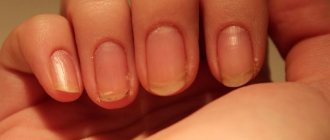Home / Waste disposal and recycling / Metals / Mercury
Back
Published: November 25, 2014
Reading time: 3 min
4
14666
Mercury is an extremely toxic substance, the handling of which requires a person to have certain knowledge. That is why it is worth paying special attention to such an item in the house as a mercury thermometer.
We all know very well that fragile things in the house sometimes break and break. A mercury thermometer is a rather fragile device; it is quite easy to break it. At the same time, you still need to properly collect the toxic metal.
But a person may not even notice that the thermometer is broken, and at this time the insidious mercury is already beginning to evaporate its toxic fumes. Therefore, every person should know the main symptoms of poisoning with this harmful substance. Knowing the symptoms will help you identify poisoning in time and remove toxins that have entered the body as soon as possible.
Use of metal in ancient medicine
In ancient times, mercury was used to treat certain pathologies. It was believed that to treat volvulus, you need to drink 0.5 pounds (~1 shot glass) of mercury. The heavy metal, passing through the intestines, must “unravel” the loops.
But such “therapy” did not justify itself, and not because of toxicity, but because the entire volume of mercury disintegrated into small balls, and the desired effect was not achieved. There were no symptoms of intoxication.
Mercury was widely used in ancient Indian medicine. One of the areas of medieval Indian alchemy is called “Rasayana”, which translates as “The Way of Mercury”.
Recipes using silver metal as the main ingredient migrated from India to the medicine of Greece and Tibet. From there, mercury therapy migrated to Arab countries and medieval Europe.
In Rus', “mercury mazuny” was used to treat various dermatological and parasitic diseases. Ointments based on this metal are still used in therapy today, as they have antimicrobial and anti-inflammatory properties.
Calomel - mercury (I) chloride is used as a laxative, powder for weeping syphilides and as part of an eye ointment in the treatment of blenorrhea and diseases of the cornea.
Sources of toxic fumes
There are several sources of poisoning from mercury vapors or salts:
Quinine
- household - the contents of a thermometer, mercury and fluorescent lamps;
- medical – some types of vaccines, amalgam fillings;
- food – marine life;
- technogenic – caustic soda production process, mercury-zinc and galvanic cells, mercury pumps and mercury-steam turbines.
In most regions of the Russian Federation, there is still an unsatisfactory situation in the disposal of mercury-containing waste, household and industrial waste. Metal contamination of domestic and industrial premises is often observed. Chronic mercury intoxication is detected in persons involved in the dismantling and demercurization of shutdown enterprises that used metal in production.
Chronic intoxication was diagnosed in the population of coastal countries, who often used sea fish, mollusks and crustaceans in their diet. Mercury has teratogenic properties. Children whose parents ate fish contaminated with mercury had mild mental retardation.
Metallic mercury vapors are the most toxic, for example, when the integrity of the capillary of a thermometer is damaged. When studying the toxic effects of mercury on laboratory animals, it was found:
- disturbance of oxidative metabolism;
- an increase in the amount of dopamine in the brain;
- damage to the ultrastructure of nervous tissue;
- changes in behavior with an increase in anxiety and depression.
The results obtained confirm the neurotoxic effects of mercury on the body.
Mechanism of intoxication and deposition of mercury
With resorptive, oral or injection administration of mercury into the body, no accumulation of metal was observed in the internal organs. But with inhalation administration of metallic mercury vapor, a high content of the metal was noted in the kidneys, brain stem structures, lungs and liver.
This uneven distribution of mercury in organs is due to the high ability of heavy metals to penetrate cytomembranes and the blood-brain barrier and be deposited in organs with a high lipid content. Penetrating into cells, the metal causes disruption of oxidative phosphorylation and the development of tissue hypoxia.
The long-term consequences of intoxication are due to the cumulative properties of mercury. Even after measures have been taken to intensively remove the metal from the organs, traces of it remain in the tissues. There are acute and chronic intoxication with metallic mercury vapors.
Mercury toxicity
There is no doubt whether mercury from a broken thermometer is dangerous. If this happens, there is a danger of mercury vapor poisoning, and most often this occurs through the skin. At the same time, the development of intoxication
is carried out slowly. It is much more dangerous if metal particles get on the mucous membranes. In this case, the liver experiences a toxic shock. The most severe poisoning situation occurs when vapors are inhaled, or if they directly enter the bloodstream, because the liver does not participate in their neutralization at all.
Quite often, human contact with mercury occurs when a thermometer is broken. The amount of mercury in a thermometer
is about two grams. A lethal dose of mercury for a person is when half of this dose enters the body.
The size of the room in which the thermometer crashed is important. Also, much depends on the gender, age and body weight of the person who came into contact with the dangerous poison. All these factors can influence
on the severity of poisoning. If urgent measures are not taken, then the probability of mercury poisoning from a thermometer is 100%, because its average toxic dose is 0.4 mg.
Yes, a broken mercury thermometer really poses a great danger to human health. According to the Great Medical Encyclopedia, mercury is a highly toxic poison belonging to the first class of extremely dangerous substances. A medical mercury thermometer contains from 1 to 2 grams of mercury; if the substance is in the room, it begins to evaporate. The concentration of mercury vapor in this case can exceed the maximum permissible limit by up to 1000 times. If the source of intoxication is not eliminated in time, mercury vapor will not disappear on its own; it will remain in the room for many years. For this reason, the production of mercury thermometers is banned in many countries.
Symptoms and manifestations of acute intoxication
Acute poisoning by metallic mercury vapor is manifested by the following symptoms:
Bee venom - description
- asthenia and muscle atony;
- lack of appetite;
- pain when swallowing;
- headache;
- metallic taste;
- hypersalivation;
- dyspeptic disorders;
- inflammation and bleeding of the gums;
- pain behind the sternum and in the abdomen;
- cough and shortness of breath;
- hyperthermia and febrile symptoms.
If the toxic dose is exceeded, the victim may die.
Symptoms of mercury vapor poisoning
Acute poisoning
The first manifestations are observed a couple of hours after direct poisoning:
- general weakness;
- headache;
- lack of appetite;
- pain when trying to swallow something;
- metallic taste;
- salivation;
- bleeding and swelling of the gums;
- nausea;
- vomit.
A little later there are:
- very severe abdominal pain, bloody diarrhea,
- cough and shortness of breath - inflammation of the lung tissue, catarrh of the respiratory tract, chest pain, severe chills are added
- characteristic rise in body temperature to 38-40 °C.
- When examined, mercury is detected in the urine.
Symptoms of mercury poisoning are the same in adults and children. Only in a child the symptoms develop faster, the clinical picture is clearer, and immediate help is required!
Chronic poisoning
Mercurialism is a general poisoning due to chronic exposure to mercury vapors and compounds, much exceeding the standards, for 2-5 months or years. Manifestations depend on the state of the body and nervous system:
- increased fatigue;
- causeless drowsiness;
- general weakness;
- dizziness;
- migraine;
- emotional disorders: self-doubt, shyness, depression, irritability.
There is a loss of self-control and weakening of memory, decreased attention. Gradually, a bright characteristic symptom develops - “mercury tremor” of the fingers and toes, lips, eyelids, which occurs with excitement. There is a urge to defecate and urinate, a decrease in the sense of smell, tactile sensitivity, taste, and increased sweating. The thyroid gland enlarges significantly, heart rhythm disturbances and a drop in blood pressure are noted.
Micromercurialism is a chronic poisoning with the symptoms described above, which occurs with constant exposure to small amounts of mercury for many (5-10 or more) years.
Consequences of chronic intoxication
Chronic intoxication, as a rule, is characteristic of occupational poisoning or prolonged inhalation of metallic mercury vapor from a broken thermometer. Often, with chronic poisoning, long-term consequences are diagnosed in the form of disorders:
- psychopathological;
- cognitive;
- neurological;
- asthenic, manifested by tremor of the fingers;
- cerebral-organic.
Moreover, the majority of victims were diagnosed with occupational chronic mercury intoxication 1-10 years after stopping contact with the metal. Similar consequences are observed if spilled mercury from a broken thermometer has not been demercurized.
Long-term consequences of intoxication manifested themselves in the form of:
- asymmetry of innervation of the facial muscles;
- cerebellar disorders:
- speech impairment (dysarthria, scanning);
- ataxic gait (the patient spreads his legs wide when walking, staggers, shuffles, drags his legs, leans towards the affected hemisphere);
- dysfunction of rapid sequential contraction of antagonist muscles (adiadochokinesis);
- impaired coordination of movements such as dysmetria;
— violation of muscle tone;
- increased tendon reflexes.
Intoxication increases the risk of manifestation of concomitant diseases of the following systems:
- blood circulation (arterial hypertension, coronary heart disease);
- nervous (polyneuropathy, encephalopathy);
- digestive (peptic ulcer of the stomach and duodenum, chronic gastritis);
- musculoskeletal (degenerative changes in the spine and joints);
- genitourinary (prostatic hyperplasia, urolithiasis, glomerulonephritis, pyelonephritis);
- endocrine (obesity, diabetes, endemic goiter);
- respiratory (chronic bronchitis, COPD);
- sensory organs (optic atrophy, hearing loss).
A characteristic sign of chronic intoxication is aggressive and antisocial behavior of the victim. Changes in the patient's behavior and character are noted.
The following signs of neuro-emotional disorders have been identified:
- depression;
- affectation;
- irritability;
- tearfulness;
- touchiness;
- suspicion;
- tendency to aggression;
- cognitive impairment with signs of dementia.
Hemlock poisoning
Vegetative disorders are accompanied by:
- vascular reactions;
- heartbeat;
- redness of the face;
- hyperhidrosis;
- shortness of breath with symptoms of titanium;
- tremor with increasing amplitude;
- involuntary urination.
The use of mercury for suicide is rare. Cases of introducing mercury into the gastrointestinal tract and intravenous injection have been described, but the expected result was not observed, since the suicides did not know that mercury vapor is the most toxic.
There is a direct relationship between exposure time, vapor volume and the severity of pathological disorders. The more severe the intoxication, the more likely the manifestation of complications and delayed pathological disorders.
If you contact a medical facility in a timely manner, the prognosis is good. A broken thermometer, as a rule, does not cause severe intoxication, especially if you managed to correctly and completely collect all the spilled liquid metal and transfer it for disposal.
What to do if a thermometer with mercury at home breaks?
The traditional mercury thermometer is popular and in demand among domestic consumers. It is cheaper and more accurate than its electronic counterparts, and also does not require consumables. To disinfect it, it is enough to wipe the surface with an alcohol-containing or antimicrobial solution. However, it can become a source of great danger, because glass is a fairly fragile material. Therefore, it is very important to know what to do if a thermometer with mercury at home breaks and what the consequences of incorrect actions are.
Caution - mercury
Mercury is a very treacherous silvery-white metal. Its peculiarity is its liquid state at room temperatures, which is uncharacteristic for this type of substance. It is fluid and has the ability to divide into tiny balls, so it easily penetrates into cracks and irregularities and is very difficult to collect. At temperatures above 18 °C it begins to evaporate. It is from the air through the lungs that mercury from a broken thermometer enters the body in large quantities (up to 80% of the available amount). Penetration through the skin is also possible, rarely through the esophagus.
Mercury is an extremely dangerous substance; according to this indicator it is classified as the highest class I. The permissible concentration in the air is no more than 0.0003 mg/m3. Whereas in a thermometer there is about 2 g. Consequently, a broken product is a real threat to human health.
Even small amounts remaining after poorly or incorrectly carried out cleaning can cause general ailments and damage to the nervous system. They are expressed by dizziness, nausea, loss of appetite, drowsiness and irritability. Sometimes they are ignored and the situation worsens. In acute mercury vapor poisoning, the following is also observed:
- increased irritability;
- decreased ability to work;
- memory impairment;
- sleep disorders.
The main route for removing mercury from the body is through the kidneys. Therefore, a significant burden falls on them. Another option is that the gums get hit with saliva. In severe poisoning, the lungs are affected. Mercury is especially dangerous for pregnant women - it penetrates the placental barrier and causes disturbances in the development of the fetus.
Mercury from a broken thermometer is especially dangerous:
- for children;
- if liquid is spilled on a warm (hot) surface, this promotes rapid evaporation;
- in a small room, since its concentration in the air will be greater than in a spacious room;
- for people who stay in the affected area for a long time without personal protective equipment.
The thermometer is broken - where to start?
If a mercury thermometer breaks in the house, it is important not to panic or fuss. First, all occupants, including four-legged animals, are removed from the room, this minimizes the risk of metal balls spreading to other rooms. Further, without lifting it, without much haste, you should inspect the device. If the mercury does not leak out, then you must:
- Prepare a glass container (a simple jar will do) with a lid;
- Carefully transfer the remaining thermometer into the vessel, making sure that the metal does not spill.
- The vessel is then handed over for disposal.
A more labor-intensive process awaits owners of broken thermometers if mercury has spilled. To prevent vapors from spreading throughout your home or apartment, it is important to keep the door tightly closed. It is better to place a rag soaked in a solution of potassium permanganate (potassium permanganate) on the threshold. The room should be ventilated, this will reduce the vapor content in the air. In addition, during the cold period the temperature will decrease and the transition of the metal into a gaseous state will be minimized or stopped.
It is also important to properly prepare for collecting mercury balls that leak from the thermometer. This procedure is especially complicated by the need to remove baseboards or move heavy furniture. You should stock up on glass containers, rubber gloves, shoe covers and plastic bags for used items. It is better to prefer synthetic clothing and stock up on a respirator or make a bandage from gauze and cotton wool. The latter should be wetted with water or a solution of baking soda before use. Side lighting will help you see the mercury balls leaking out of the thermometer better.
Removing mercury from a relatively flat surface
If the thermometer breaks on a flat floor without cracks, a table or other similar surface, then to collect it you will need:
- a couple of sheets of thick paper or foil;
- cotton wool, a brush or a brush with soft bristles, but remember, it will have to be disposed of;
- tape or roll plaster;
- a jar or other glass sealable vessel, it can be filled with a demercurizer solution.
Cleaning is done sequentially, starting from the periphery. Illuminating with a table lamp or flashlight, small balls are carefully rolled into a large ball using paper or foil. The same actions can be carried out using cotton wool or a brush. Place the resulting ball on paper and pour into a jar. During work, it is important to ensure that mercury does not come into contact with exposed skin.
As a tool for eliminating the consequences of a broken thermometer, it is convenient to use small copper (plate or twisted wire) or copper-containing (bronze coin) objects. Since this metal attracts mercury and prevents it from spreading. It is convenient to collect very small particles of mercury with tape or adhesive tape. You should tear off small pieces and carefully press them to the surface. Place the patch together with the “caught” mercury in a jar.
When carrying out work for a long time, it should be done every 15 minutes. go out for some fresh air. If cleaning is carried out indoors without ventilation (for example, in the heat of summer), then the interval should be reduced by 5 minutes. When leaving the room, it is important not to forget to take off your shoe covers and gloves.
Removing mercury from cracks and other difficult cases
If some of the metal from a broken thermometer gets into the cracks, then to remove it you will need a syringe or a rubber bulb with a thin spout. You can also use a thick knitting needle, but you must act very carefully so that the mercury balls do not break up. These devices collect the metal into a jar. Very small parts are easier to remove by pouring a little sand into the cracks. It is swept away with a brush or shaving brush along with the remaining mercury. If there are large irregularities, it is worth considering unscheduled repairs.
Sometimes a thermometer breaks in a very “inconvenient” place - on a fleecy carpet, next to it, or on a child’s toy. In this case, the easiest way is to say goodbye to the thing. If it is very expensive, then you can turn to specialists for help or do self-cleaning using a chemical method. But in the latter case, the procedure should be carried out especially carefully, otherwise there is no guarantee of a positive result.
Chemical cleaning methods
After mechanical (manual) collection of mercury from a broken thermometer, final cleaning of the surfaces should be carried out. All items previously used for disposal are carefully packed in plastic bags and removed from the premises. Chemical treatment can be carried out in several ways, all of which are aimed at converting (binding) toxic mercury into non-toxic compounds.
The simplest is using potassium permanganate (potassium permanganate, potassium permanganate). It is diluted in water to obtain a saturated dark solution, which is applied to the contaminated surface using a brush, sponge or spray bottle. Liquid is also poured into cracks and seams. Despite the high efficiency of this method, it is not always possible to implement it, since potassium permanganate is withdrawn from free sale.
Chlorine-containing substances help to cope well with mercury residues. One of the most effective is a saturated solution of iron trichloride, which is carefully applied to all surfaces and left for a day, after which it is thoroughly washed off. Can also be used:
- bleaching powder;
- disinfectants or bleaches containing chlorine, including classic “Whiteness”;
- chloramine
If a powder product is used, it is scattered at the site of the mercury spill and moistened with water. After a few hours, the pulp should be collected in a plastic bag, and the surface should be washed with a damp cloth.
An iodine solution can also be used for disinfection. When applied, mercury turns into salt - a black precipitate that is completely safe for humans. A simple option is a soap-soda solution (for each liter of warm water, take 40 g of grated laundry soap and 50 g of soda). Some sources claim the effectiveness of powdered sulfur in collecting mercury from a broken thermometer. But its use is controversial, since the reaction occurs at the metal-sulfur interface and is not fast enough to completely neutralize the dangerous substance. Its compounds are used, for example, sodium thiosulfate, which is used as a photofix.
Take care of yourself
After completing work to eliminate the consequences of a broken mercury thermometer, you should take care of yourself. All clothing is carefully removed and packed in bags. The mouth should be rinsed with a weak (pale pink) solution of potassium permanganate. It wouldn't hurt to take a few tablets of activated carbon. To minimize the likelihood of kidney complications, you should drink plenty of fluids and milk.
It would be a good idea to ventilate the room over the next few days after disinfection. You can also do wet cleaning using chlorine-containing products.
Taboo with a broken thermometer
If a thermometer breaks in the house, you should not rush to get a vacuum cleaner. Using it will only make the situation worse. First of all, this will lead to an increase in the content of mercury vapor in the air, and the unit itself will become a constant source of replenishment each time it is turned on. Therefore, after collecting mercury with a vacuum cleaner, you will have to throw it away.
When ventilating, it is important not to create a draft in the room. Otherwise, it will spread the smallest particles of mercury throughout the room, and it will become impossible to collect them completely. It is also inappropriate to use a broom and rags. They only smear and crush mercury balls, but do not collect them. You cannot wash things and wash off metal residues down the drain, as its particles linger on the walls of the pipes. They will gradually evaporate, creating a constant threat to people and animals.
To avoid environmental pollution, it is important to follow proper mercury disposal guidelines. You cannot put its remains and things in contact with it into garbage chutes or containers, burn them or bury them. It is important to carefully collect, pack and hand over everything to a specialized service.
A mercury thermometer is a useful and inexpensive thing, but it should be used extremely carefully. If trouble happens and it crashes, then it is important not to panic and act thoughtfully. Only by following simple rules and taking into account prohibitions can you completely protect yourself and others.











